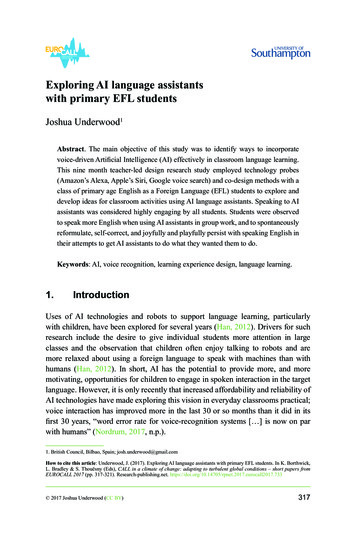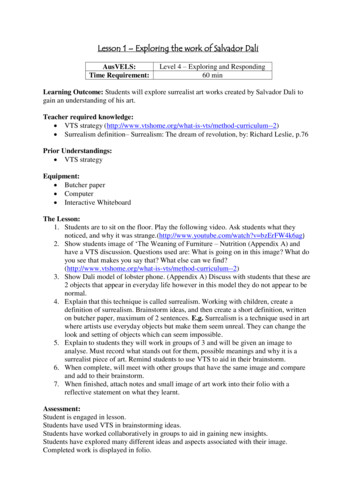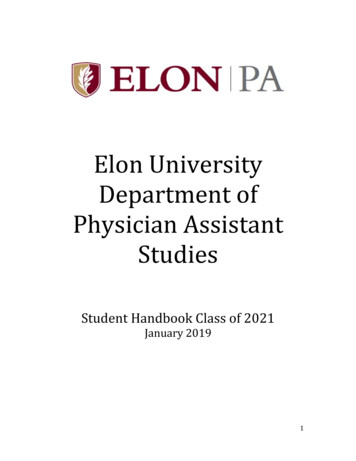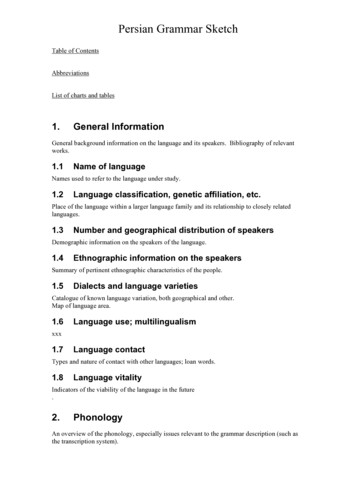
Transcription
Exploring AI language assistantswith primary EFL studentsJoshua Underwood1Abstract. The main objective of this study was to identify ways to incorporatevoice-driven Artificial Intelligence (AI) effectively in classroom language learning.This nine month teacher-led design research study employed technology probes(Amazon’s Alexa, Apple’s Siri, Google voice search) and co-design methods with aclass of primary age English as a Foreign Language (EFL) students to explore anddevelop ideas for classroom activities using AI language assistants. Speaking to AIassistants was considered highly engaging by all students. Students were observedto speak more English when using AI assistants in group work, and to spontaneouslyreformulate, self-correct, and joyfully and playfully persist with speaking English intheir attempts to get AI assistants to do what they wanted them to do.Keywords: AI, voice recognition, learning experience design, language learning.1.IntroductionUses of AI technologies and robots to support language learning, particularlywith children, have been explored for several years (Han, 2012). Drivers for suchresearch include the desire to give individual students more attention in largeclasses and the observation that children often enjoy talking to robots and aremore relaxed about using a foreign language to speak with machines than withhumans (Han, 2012). In short, AI has the potential to provide more, and moremotivating, opportunities for children to engage in spoken interaction in the targetlanguage. However, it is only recently that increased affordability and reliability ofAI technologies have made exploring this vision in everyday classrooms practical;voice interaction has improved more in the last 30 or so months than it did in itsfirst 30 years, “word error rate for voice-recognition systems [ ] is now on parwith humans” (Nordrum, 2017, n.p.).1. British Council, Bilbao, Spain; josh.underwood@gmail.comHow to cite this article: Underwood, J. (2017). Exploring AI language assistants with primary EFL students. In K. Borthwick,L. Bradley & S. Thouësny (Eds), CALL in a climate of change: adapting to turbulent global conditions – short papers fromEUROCALL 2017 (pp. 317-321). Research-publishing.net. 33 2017 Joshua Underwood (CC BY)317
Joshua UnderwoodFor some, the idea of affordable AI in the classroom raises concerns about the roleof teachers, teacher replacement, and loss of human values. Others emphasise waysAI and teachers may work together and even ‘humanise’ classes, for example byremoving the need for standardised testing (Luckin & Holmes, 2017). Interestingly,the idea of robot teachers doing away with the need for tests, though verydifferently conceived, is also present in some children’s visions of robot-assistedlearning (Underwood, 2016). Essentially, the enthusiastic argument expressed inone student’s essay is that, as robot teachers will have a complete record of allinteraction with the student, they will be able to generate an accurate assessment ofcompetence without the need for tests. While conscious of concerns, as a teacherI personally view AI assistants as potentially engaging and useful and it is in thisspirit that this study was conducted.The study reported here is teacher-led research motivated by the desire to addressclassroom challenges encountered on returning to teaching primary age students, aspecific example being the need to simultaneously answer spontaneous questionsfrom several children at once (e.g. “How do you say in English? How do youspell ? What does mean? Etc.) and the observation that many of those questionsmight easily and satisfactorily be answered by currently available AI technologies.The study addresses two questions: (1) Can currently available AI technologiesprovide children with satisfactory answers to some of the questions that are verycommon in language classrooms?; and (2) How might we exploit AI to get childrenspeaking in the target language?Further objectives of this study are to provide insights into: ways of supportingchildren in developing appropriate AI-assisted task designs; classroom managementissues when working with AI classroom assistants; and other practicalities such ascoping with inaccurate voice-recognition.2.MethodThe ‘in the wild’ design approach (Rogers, 2011) adopted in this study employedexisting AI technologies as probes to stimulate children and teachers to think aboutcurrent and future opportunities for using AI in natural classroom settings over aperiod of nine months so as to address issues of novelty and ecological validity aswell as revealing practical issues. During the study, the author/teacher and a classof 11 primary-age EFL students made frequent use of various AI technologies (asingle Amazon Alexa; Siri on a class set of iPads: Google voice search on theteacher’s mobile phone and iPads) to support various classroom activities. Example318
Exploring AI language assistants with primary EFL studentsuses included: student-directed ‘free’ language use in research for project work(e.g. “Alexa, how much does an Osprey weigh?”); teacher-directed controlledpractice of hard to distinguish sounds (e.g. “Ok Google, show me a picture of aship/sheep”); and challenges like “Which group can get Alexa to answer the mostcomplicated question?”. Over time we gradually moved from teacher-designed tostudent-designed tasks and more spontaneous integrated uses, e.g. students saying“Why don’t we ask Google?”.As in Underwood (2014), I employed co-design strategies (e.g. Arnold, Lee, &Yip, 2016) to support children in reflecting on these experiences and help themdevelop and communicate their own ideas about what AI language assistants mightbe like and how they might be used. Co-design activities included developing playdoh models of ‘English Helpers’, describing what they could do, and designingposters and short presentations about “robot teachers” with peer feedback. As weshall see, these methods influence the kind of results obtained and will be revisedin future studies (Figure 1).Figure 1. Primary children’s play-doh representations of ‘My English Helper’3.Results and discussionCan currently available AI technologies provide children with satisfactoryanswers to some of the questions that are very common in language classrooms?The answer to this varied depending on which AI was used. How do you spellwas mostly answered correctly but often too fast and is far easier for students319
Joshua Underwoodto make use of when they both see and hear the spelling (e.g. Siri and Google).What does [ ] mean was often answered correctly but frequently not in waysthat were easily understood by primary-age EFL learners. How do you say [ ] inEnglish was rarely understood but occasionally correctly answered, for Spanishwords, by Google. Generally students quickly learnt what was not likely to geta satisfactory answer and how to phrase questions in ways that were more likelyto be answered. Despite current generally poor performance on these kinds ofquestions, it seems highly-likely that this could be greatly enhanced throughvoice interaction designs specific for language classrooms and particular firstlanguage backgrounds.How can we exploit AI to get children speaking in the target language? Thechildren in this study were intrigued by what any particular implementation ofAI was capable of and highly motivated to test their ideas through trial and error,thus engaging in extensive interactive target language speaking whilst developingpotentially valuable 21st century skills for working with AI. Speaking to AIsengaged these children’s natural curiosity, largely in order to explore what theAIs were and were not capable of. For these children, asking questions, givingcommands (e.g. “play some music”), and getting a response appears to have madespeaking English meaningful and often joyful, even when they were not understoodthey often tried again, reformulated, and persisted. However, activities resulting inlinked utterances, students’ responding to AIs utterances, and conversations werefar harder, though some Alexa skills such as ‘Guess the animal’ worked to someextent.How can we support children in developing appropriate AI-assisted task designs?These students tended to design AI language helpers that were anthropomorphicand more like friends that would play with them. However, the activities theywould like AI assistants to engage in with them (e.g. “be my friend”, “play videogames with me”) were under-described probably because the co-design methodsemployed did not sufficiently scaffold the development of such ideas. In futurestudies, I aim to use storyboards, scripting of skills to implement as programmes,and peer evaluation to help children design AI-assisted tasks.What are classroom management issues when working with AI classroomassistants? Inaccurate voice-recognition can result in inappropriate search results,so ensure safe-search is on. Voice-recognition works poorly when studentsspeak simultaneously so they need to develop turn-taking. Students engage soenthusiastically that you need to develop good strategies for stopping activity andgetting attention.320
Exploring AI language assistants with primary EFL students4.AcknowledgementsI would like to thank all my students who so enthusiastically engaged with thevarious technologies we tried out and so generously shared their ideas.ReferencesArnold, L., Lee, K. J., & Yip, J. C. (2016). Co-designing with children: an approach to socialrobot design. In Proceedings 2nd Workshop on Evaluating Child Robot Interaction at HRI2016. workshop-hri-2016/Han, J. (2012). Emerging technologies: robot assisted language learning. Language Learning &Technology, 16(3), 1-9. Luckin, R., & Holmes, W. (2017, January 04). A.I. is the new T.A. in the classroom – how weget to next. he-classroom-dedbe5b99e9eNordrum, A. (2017, January 04). CES 2017: the year of voice recognition. onRogers, Y. (2011). Interaction design gone wild. Interactions, 18(4), 58. https://doi.org/10.1145/1978822.1978834Underwood, J. (2014). Using iPads to help teens design their own activities. In S. Jager, L. Bradley,E. J. Meima & S. Thouësny (Eds), CALL design: principles and practice - proceedings ofthe 2014 EUROCALL conference, Groningen, The Netherlands (pp. 385-390). Researchpublishing.net. d, J. (2016). Recurrent themes in 80 young learners’ essays about their ideal futurelanguage learning classes. Unpublished report. British Council.321
Published by Research-publishing.net, not-for-profit associationContact: info@research-publishing.net 2017 by Editors (collective work) 2017 by Authors (individual work)CALL in a climate of change: adapting to turbulent global conditions – short papers from EUROCALL 2017Edited by Kate Borthwick, Linda Bradley, and Sylvie ThouësnyRights: This volume is published under the Attribution-NonCommercial-NoDerivatives International (CC BY-NC-ND)licence; individual articles may have a different licence. Under the CC BY-NC-ND licence, the volume is freely availableonline 9782490057047) for anybody to read, download, copy, andredistribute provided that the author(s), editorial team, and publisher are properly cited. Commercial use and derivativeworks are, however, not permitted.Disclaimer: Research-publishing.net does not take any responsibility for the content of the pages written by the authorsof this book. The authors have recognised that the work described was not published before, or that it was not underconsideration for publication elsewhere. While the information in this book are believed to be true and accurate on the date ofits going to press, neither the editorial team, nor the publisher can accept any legal responsibility for any errors or omissionsthat may be made. The publisher makes no warranty, expressed or implied, with respect to the material contained herein.While Research-publishing.net is committed to publishing works of integrity, the words are the authors’ alone.Trademark notice: product or corporate names may be trademarks or registered trademarks, and are used only foridentification and explanation without intent to infringe.Copyrighted material: every effort has been made by the editorial team to trace copyright holders and to obtain theirpermission for the use of copyrighted material in this book. In the event of errors or omissions, please notify the publisher ofany corrections that will need to be incorporated in future editions of this book.Typeset by Research-publishing.netCover design based on Josef Brett’s, Multimedia Developer, Digital Learning, http://www.eurocall2017.uk/, reproducedwith kind permissions from the copyright holder.Cover layout by Raphaël Savina (raphael@savina.net)Photo “frog” on cover by Raphaël Savina (raphael@savina.net)Fonts used are licensed under a SIL Open Font LicenseISBN13: 978-2-490057-04-7 (Ebook, PDF, colour)ISBN13: 978-2-490057-05-4 (Ebook, EPUB, colour)ISBN13: 978-2-490057-03-0 (Paperback - Print on demand, black and white)Print on demand technology is a high-quality, innovative and ecological printing method; with which the book is never ‘outof stock’ or ‘out of print’.British Library Cataloguing-in-Publication Data.A cataloguing record for this book is available from the British Library.Legal deposit: Bibliothèque Nationale de France - Dépôt légal: décembre 2017.
For some, the idea of affordable AI in the classroom raises concerns about the role of teachers, teacher replacement, and loss of human values. Others emphasise ways AI and teachers may work together and even ‘humanise’ classes, for example by removing the need for standar










